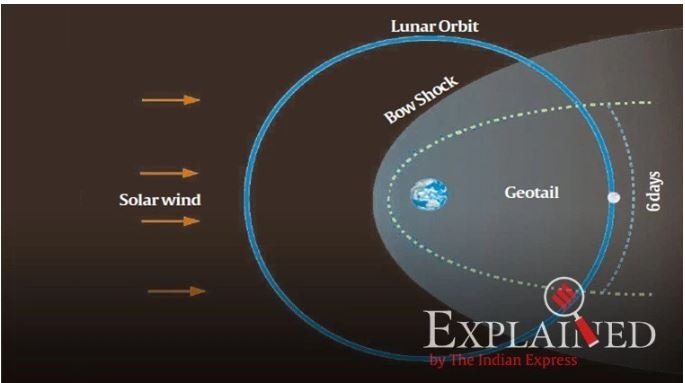Geotail | 07 Oct 2019
Recently, an instrument on Chandrayaan-2 named CLASS (Chandrayaan-2 Large Area Soft X-ray Spectrometer) has detected charged particles present on the moon soil during the orbiter’s passage through the “Geotail”.
- According to ISRO, the intensity of these charged particles (believed to be mostly electrons) changed as much as ten times the levels outside the Geotail.
- The detection of these charged particles on the surface of the moon can help understand the complex interaction of these particles with the magnetic field.
- It will also help to measure the fluxes, energy spectra, and charge types of charged particles bombarding the lunar surface and to investigate the interaction of these particles and other forms of radiation with the lunar surface.
- The Geotail region exists as a result of the interactions between the Sun and Earth.
- The Sun emits the solar wind, which is a continuous stream of charged particles.
- These particles are embedded in the extended magnetic field of the Sun.
- Since the Earth has a magnetic field, it obstructs the solar wind plasma.
- This interaction results in the formation of a magnetic envelope around Earth.
- On the Earth side facing the Sun, the envelope is compressed into a region that is approximately three to four times the Earth's radius.
- On the opposite side, the envelope is stretched into a long tail, which extends beyond the orbit of the Moon called the Geotail.
- Once every 29 days, the Moon traverses the Geotail for about six days.
- The Geotail region allows the best scientific observations.
Chandrayaan-2 Large Area Soft X-ray Spectrometer (CLASS)
- The objective of CLASS is to map the abundance of major rock-forming elements on the lunar surface using the technique of X-ray fluorescence during solar flare events.
- The solar flare provides a rich source of X-rays to illuminate the surface.
- Secondary X-ray emission resulting from this can be detected by CLASS to directly detect the presence of key elements like Sodium (Na), Calcium (Ca), Aluminium (Al), Iron (Fe), etc. on the lunar surface.

